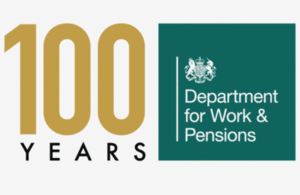A century of support: Department for Work and Pensions turns 100 years old
This week DWP turns 100 years old, marking a century of supporting people into jobs and encouraging them to save for their future.

Department for Work and Pensions: 100 years
Through 14 name changes, 77 Secretaries and Ministers of State, and across more than 700 jobcentres throughout the country, the department has been at the forefront of improving people’s lives.
In 1942 William Beveridge set out how he would tackle the ‘5 giant evils of society’ and create the framework for the modern welfare state. In 2016 DWP continues to meet these challenges, working to reduce poverty, increase financial inclusion, cut workplace accidents and promote greater saving for retirement.
Through reforms such as Universal Credit, the new State Pension and Personal Independence Payment, DWP helps millions of people find work, secure dignity in retirement and regain independence from ill health every single day.
Secretary of State Damian Green said:
Although I only joined the department in July this year, it is an honour to be able to mark its 100th anniversary as a ministry. The welfare state we know today is older still, having been over a century in the making.
But throughout our existence, we have been helping people find work, which I believe is one of the prime objectives of the welfare system. I am proud to be part of that and look forward to building on our history to create a modern, civilised and fair welfare system, fit for the world of work in the 21st century.
A century of support: Department for Work and Pensions turns 100-years-old
As Whitehall’s biggest department, DWP employs nearly 88,000 staff who work tirelessly to support millions of people, handling payments worth £176 billion.
With around 22 million people receiving support from the welfare state every single year, DWP provides vital security for some of the most vulnerable individuals in society.
Permanent Secretary Robert Devereux said:
Since its inception 100 years ago, DWP has, in a variety of incarnations, tackled major change time and again, including most recently our welfare reforms and service transformation.
In my 6 years here I have met many colleagues who have built their careers in DWP and will have their own memories of our highs and lows. But whether supporting pensioners, disabled people, separated families or those seeking work, the obvious constant has been the importance of the work we do.
The unwavering commitment and effort over hundreds of thousands of days that colleagues and their predecessors have invested has helped millions of customers at times of major vulnerability and upheaval in their lives.
Timeline of DWP events
- 1916: George Barnes was announced as the Minister of Pensions and John Hodge the first Minister of Labour
- 1917: John Hodge succeeds George Barnes as the second Minister of Pensions until 1919
- 1929: History was made when Margaret Bondfield accepted the post of Minister of Labour as she became Britain’s first female cabinet minister and first female privy counsellor
- 1939: Ministry of Labour renamed Ministry of Labour and National Service
- 1945: Sir William Beveridge’s landmark welfare reforms start, covering the whole working age population. In return for weekly contributions, cash benefits would be provided at a flat rate to give contributors and their dependents insurance against want
- 1948: The basic State Pension was introduced
- 1953: Ministries of Pensions and National Insurance merge
- 1966: Supplementary Benefit supercedes National Assistance
- 1977: Child Benefit – introduced in April 1977 to replace the Family Allowance and the Child Tax Allowance, non-taxable, non-contributory, non-means-tested
- 1982: First computers introduced into the DHSS
- 1992: Disability Living Allowance introduced
- 2001: Departments of Social Security and Employment merge to form Department for Work and Pensions
- 2002: Jobcentre Plus is set up as an executive agency of DWP
- 2012: Introduction of automatic enrolment into workplace pensions
- 2013: Universal Credit and Personal Independence Payment starts
- 2016: New State Pension launches
Background material
Historical images of the department are available from the specially created DWP: A century of public service Shorthand Social photosite.
These are free for use and reproduction. Film footage is available on request.
The Department for Work and Pensions was created in 2001, but existed prior to this in separate ministries, which were:
- Ministry of Labour (1916)
- Ministry of Pensions (1916)
- Ministry of Labour and National Service (1939)
- Ministry of National Insurance (1944)
- Ministry of Pensions and National Insurance (1953)
- Ministry of Labour (1959)
- Ministry of Social Security (1966)
- Department for Employment and Productivity (1968)
- Department of Health and Social Security (1968)
- Department of Employment (1970)
- Employment Department (1988)
- Department of Social Security (1988)
- Department for Education and Employment (1995)
- Department for Work and Pensions (2001)
DWP in numbers
The department has had 14 name changes (see the department and ministry list above).
The department has had 77 Secretaries and Ministers of State, including:
- one Prime Minister – Edward Heath in 1959
- Britain’s first female cabinet minister – Margaret Bondfield in 1929.
- Britain’s first ever blind cabinet minister – David Blunkett in 1997
- 6 Treasury ministers, and one Chancellor of the Exchequer – Alistair Darling, Yvette Cooper, John Boyd-Carpenter, Patrick Jenkin, John Moore, Andrew Smith
DWP has:
- more than 700 jobcentre offices across Britain
- 87,910 staff
- 13 agencies and public bodies
- handles payments for 22 million people every year, worth £176 billion
Contact Press Office
Media enquiries for this press release – 0203 267 5112
Press Office
Caxton House
Tothill Street
London
SW1H 9NA
Telephone: 0115 965 8781
Follow DWP on:
- Twitter – www.twitter.com/dwppressoffice
- Facebook – www.facebook.com/dwp
- LinkedIn – www.linkedin.com/company/dwp
- YouTube – www.youtube.com/dwp